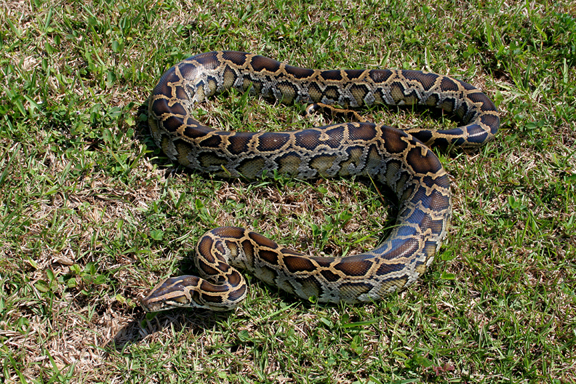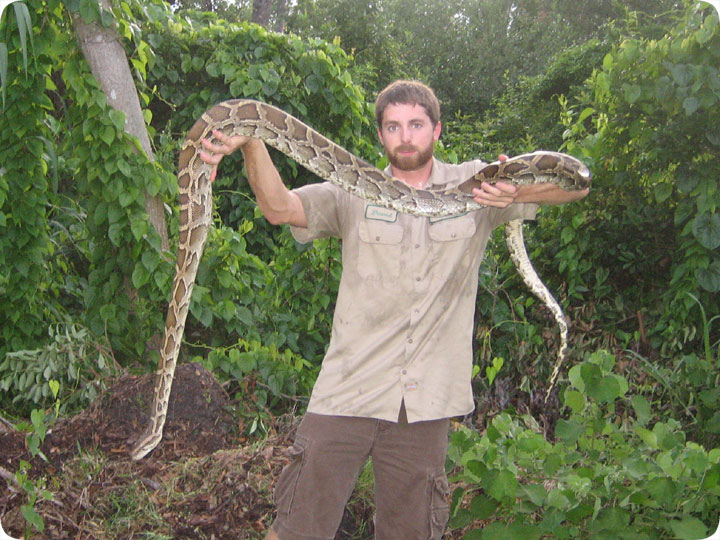In South Florida, the Burmese Python has been causing problems for wildlife. The Burmese Python is a species nonnative to Florida, introduced to the wild by pet trade. Pet owners purchased the python not realizing it grew more than 12 feet in length and thus were forced to release it into the wild. Currently the python is affecting species populations beyond small critters, due to its large size, it is able to consume foxes, bobcats, and raccoons. Due to it's ability to eat larger prey and its high breeding rate, its population in Florida has reached up to 100,000. Species which are nonnative to environments can cause large ecological problems due to lack of predation. Burmese Python is just one of the thousands of invasive species that exist in the US. 

Pet trade causes many problems by introducing nonnative species to an area, the snake trade is just a small portion. Currently at least 2 million constrictor snakes have been imported since the 1970s. Three years ago, the Fish and Wildlife Service banned the transport and import of 4 species of constrictors, the Burmese Python included. To follow up with this, last month 4 new species were added to this list of prohibited constrictors. Florida has even held a Python Challenge which allowed for Pythons to be hunted and killed in Florida, this barely affected the population.
The article fails to provide major information as far as the actual affects the Burmese Python is having within the environment. It mentions overall affects to populations of larger mammals in the everglades put provides no reference to research with the exception of mentioning the Retro Report, a series of documentaries which follows the Burmese Python. Rather than using specific data and research conducted, it focuses on inducing fear through a specific incidence in which an infant was strangled by a malnourished, pet Burmese Python. While it introduces the problems of the Burmese Python, it fails to detail the major issues of the ecological problems this snake is causing. This is most likely due to its target audiences as the article was written for the NY Times and directed more to a general audience rather than wildlife conservationist, etc.

While policies are being made in order to try to control the population, there are many issues with these new policies, these species already exist and are continue to breed at a high rate and fail to handle the species that already exist in the environment. The population will continue to grow for Burmese Python if something is not done to directly affect the pythons currently existing in the US. Pet trade needs to be more heavily regulated as the Python is no the only specie that continues to cause problems in the wild.
The article can be found here: www.nytimes.com/2015/04/06/us/the-burmese-python-snake-thats-eating-florida.html?_r=1
3 comments:
I love this post and appreciate the message behind it. Having grown up in South Florida, I have experienced my share of wild "exotic pets". I can remember a huge albino burmese python hanging out in my orange tree in the backyard one day. At the time, I had a medium sized dog and I am just thankfull that the snake was not hungry. Another species that seemed to dominate the area, were Iguanas!
The article does mention that the pythons have nearly wiped out several types mammals in the area.
I have strong negative feelings about exotic pet trade (or the pet trade in general actually), AND America's lack of interventions to stop all that because of the "freedom" to do things in this country. I had the opportunity to visit the Black Pine Animal Sanctuary in Indian last summer, and saw tigers and wolves and bears and other animals that are supposed to be wild and free in their native homes there, all because some super irresponsible, ill-educated rich American boneheads decided to keep rare animals to look cool only to realized--woops they smell, woops, they get bigger than how big they were when they were babies, woops they do make noises and I can't handle that...
I hope people in newer generations become more considerate about nature from primary and secondary education, but that's yet another problem in the land of the free, and in other places too, although other places won't just let you keep big huge bears in your backyard.
Post a Comment